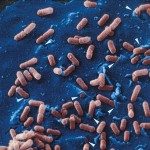Lien vers Pubmed [PMID] – 1965218
Mol. Microbiol. 1990 Dec;4(12):2167-78
Listeriolysin O (LLO), a major virulence factor of the intracellular bacterium Listeria monocytogenes, shares with other known ‘thiol-activated toxins’ a conserved undecapeptide, ECTGLAWEWWR, located in the C-terminal region of the protein and containing the unique cysteine of the molecule. Single amino acid substitutions were created in this region to study the role of cysteine and tryptophan residues in the lytic activity of LLO as well as in the virulence of the bacterium. Transformation of a transposon-induced non-haemolytic mutant with plasmids carrying the mutated genes allowed allele exchange and transfer of mutations on to the chromosome by in vivo recombination. The mutant strains secreted a full-length 59 kilodalton LLO. A decrease of 25% in the haemolytic activity in culture supernatants was observed in the case of mutation Cys-484 to Ala and of 80% for mutation Cys-484 to Ser. Mutations Trp-491 and Trp-492 to Ala decreased activity by, respectively, 95% and 99.9%. LLOs produced by the mutants, as the wild type, were active at low pH, inhibited by cholesterol, and able to bind to cell membranes. A close relationship was found between virulence of mutants in the mouse model and haemolytic activity in their culture supernatants. These results demonstrate that the thiol group of Cys-484 is not essential for either haemolytic activity in vitro or virulence in vivo. In contrast, Trp-492 appears to be required for both haemolytic activity and virulence. The finding that the nearly non-haemolytic mutant Trp-492-Ala persisted in the spleen for several days after inoculation indicates that mutagenesis of a virulence determinant can attenuate virulence and provides a novel approach to the development of live vaccine strains.

